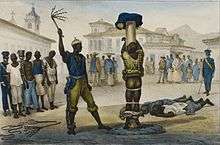Switch (corporal punishment)
A switch is a flexible rod which is typically used for corporal punishment. Switching is similar to birching.
| Part of a series on |
| Corporal punishment |
|---|
 |
| By place |
| By implementation |
| By country |
| Court cases |
| Politics |
Punitive switching
Switches are typically made of strong and flexible wood, such as hazel (also used for a very severe birch) or hickory. Birch and willow branches are also used, as well as branches from strong trees and large shrubs. Switches are often nearby from a garden, an orchard or taken from the wild. In the Southeastern United States, fresh-cut, flexible cane (Arundinaria) is commonly used. The usage of switches has been hotly contested in North America and Europe.[1]
Making a switch involves cutting it from the stem and removing twigs or directly attached leaves. For optimal flexibility, it is cut fresh shortly before use, rather than keeping it for re-use over time. Some parents decide to make the cutting of a switch an additional form of punishment for a child, by requiring the disobedient child to cut his/her own switch.
- The tamarind switch (in Creole English tambran switch) is a judicial birch-like instrument for corporal punishment made from three tamarind rods, braided and oiled, used long after independence in the Caribbean Commonwealth island states of Jamaica and Trinidad & Tobago.[2]
- The Gilbertese tribal community at Wagina in Choiseul province (Solomon Islands) reintroduced by referendum in 2005 traditional "whipping" with coconut tree branches for various offences – the national justice system opposes this.[3]
See also
References
- Gould, Mark (January 9, 2007). "Sparing the Rod". The Guardian. London: Guardian News and Media. Retrieved February 5, 2009.
- Parker, Quincy (March 7, 2007). "Human Rights Abuse Concerns". The Bahama Journal. Jones Communications Nassau Bahamas. Retrieved February 5, 2009.
- "Floggings cut crime: village leader". AAP. The Sydney Morning Herald. March 9, 2006. Retrieved February 5, 2009.